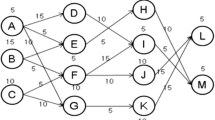Abstract
In this paper, several efficient migration and allocation strategies have been compared on the mesh-based multiprocessor systems. The traditional non-preemptive submesh allocation strategies consist of two row boundary (TRB) and two column boundary (TCB). The existing migration mechanisms are online dynamic compaction-four corner (ODC-FC), limited top-down compaction (LTDC), TCB, and the combination of TCB and ODC-FC algorithms. Indeed, the new allocation method is presented in this paper. This mechanism has the benefits of two efficient traditional allocation algorithms. It is the combination of the TCB and TRB allocation methods. Also, in this process the impact of four key metrics on online mapping is considered. The parameters are average task execution time (ATET), average task system utilization (ATSU), average task waiting time (ATWT), and average task response time (ATRT). Using TCB and TRB mechanism with the migration strategies is shown that the new algorithm has better ATET, ATRT, ATWT, and ATSU. It has, respectively, 23.5494, 97.1216, 39.1291, and 4.142% improvements in comparison with the previous mechanisms.


















Similar content being viewed by others
References
Bani-Ahmad S (2011) Bounded gradual-request-partitioning-based allocation strategies in 2D mesh multicomputers. Int J Digit Content Technol Appl 5(1):43–54
Bani-Mohammad S, Ould-Khaoua M, Ababneh I, Machenzie L (2006) Non-contiguous processor allocation strategy for 2D mesh connected multicomputers based on submeshes available for allocation. In: 12th International Conference on Parallel and Distributed Systems (ICPADS’06), vol 2. IEEE Computer Society Press, USA, pp 41–48
Ababneh I (2006) An efficient free-list submesh allocation scheme for two-dimensional mesh-connected multicomputers. J Syst Softw 79(8):1168–1179
Bani-Mohammad S, Ould-Khaoua M, Ababneh I, Machenzie L (2007) A fast and efficient processor allocation strategy which combines a contiguous and non-contiguous processor allocation algorithms. Technical Report TR-2007-229, DCS Technical Report Series, Department of Computing Science, University of Glasgow
Windisch K, Lo V, Bose B (1995) Contiguous and non-contiguous processor allocation algorithms for k-ary n-cubes. Technical Report, University of Oregon, Oregon
Windisch K (1997) ProcSimity V4.3 User’s Manual. University of Oregon
Bani-Mohammad S (2008) Efficient processor allocation strategies for mesh-connected multicomputers. PhD Thesis, The Faculty of Information and Mathematical Sciences University of Glasgow, Glasgow
Bani-Mohammad S, Ould-Khaoua M, Ababneh I, Mackenzie L (2009) Comparative evaluation of contiguous allocation strategies on 3D mesh multicomputers. J Syst Softw 82(2):307–318
Windisch KJ, Liu W, Nitzberg B (1997) Non-contiguous processor allocation algorithms for mesh-connected multicomputers. IEEE Trans Parallel Distrib Syst 8(7):712–726
Goh LK, Veeravalli B (2008) Design and performance evaluation of combined first-fit task allocation and migration strategies in mesh multicomputer systems. J Parallel Comput 34(9):508–520
Reza A, Rafie M (2015) Improving multi task running time in two column boundary allocation method in mesh-based chip multiprocessors using combined migration mechanisms. Int J Comput Inf Technol 3(3):743–755
Sharma DD, Pradhan DK (1993) A fast and efficient strategy for submesh allocation in mesh-connected parallel computers. In: Fifth IEEE Symposium on Parallel and Distributed Processing. pp 682–689
Chmaj G, Zydek D, Koszalka L (2004) Allocation algorithms problems in mesh-connected systems
Reza A, Rafie M (2015) Performance improvement in multiprocessors using two row boundary allocation method and online dynamic compaction algorithm. Int J Comput Appl 123(1):14–20
Rafie M, Khademzadeh A, Reza A, Reshadi M (2016) Performance evaluation of task migration in contiguous allocation for mesh interconnection topology. J Supercomput 72(4):1660–1677
Rafie M, Reza A, Khademzadeh A, Reshadi M (2016) External fragmentation aware dynamic multi task mapping on mesh interconnection. J Comput Theor Nanosci 13(1):958–963
Bani-Ahmad S (2011) On improved processor allocation in 2D mesh-based multicomputers: controlled splitting of parallel requests. In: International Conference on Communication, Computing and Security (ICCCS’11), pp 204–209
Kee GL (2005) Design and performance evaluation of migration-based submesh allocation strategies in mesh multicomputers. Master Thesis, National University of Singapore
Zolfaghari R (2013) Efficient and quick algorithm for processor allocation in mesh multi-computers network. Int J Eng Adv Technol 2(5):517–523
Al-Lami ZM (2011) Communication impact on non-contiguous allocation strategies for 2-D mesh multicomputer systems. Master Thesis, Middle East University, Amman
Author information
Authors and Affiliations
Corresponding author
Rights and permissions
About this article
Cite this article
Reza, A., Rafie, M. Limited contiguous processor allocation mechanism in the mesh-connected multiprocessors using compaction. J Supercomput 73, 4158–4189 (2017). https://doi.org/10.1007/s11227-017-2031-9
Published:
Issue Date:
DOI: https://doi.org/10.1007/s11227-017-2031-9




